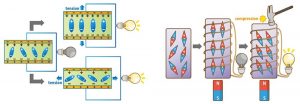 In the coming era of the internet of things (IoT), wireless sensor networks that monitor, detect, and gather data will play a crucial role in advancements in public safety, human healthcare, industrial automation, and energy management. Batteries are currently the power source of choice for operating wireless network devices due to their ease of installation. And they are considered to be an indispensable factor for developing most wearable technologies.
In the coming era of the internet of things (IoT), wireless sensor networks that monitor, detect, and gather data will play a crucial role in advancements in public safety, human healthcare, industrial automation, and energy management. Batteries are currently the power source of choice for operating wireless network devices due to their ease of installation. And they are considered to be an indispensable factor for developing most wearable technologies.
For these reasons, batteries should be lightweight and flexible, and be small in size. However, currently they require periodic replacement due to capacity limitations. Within the scope of the IoT, battery maintenance of the trillion sensor nodes that may be implemented would be practically not feasible from environmental, resource, and labor cost perspectives. In this sense, energy harvesting topics that do not use conventional batteries are a promising approach for next generation IoT technologies.
Considering individual self-powered sensor nodes, the idea of harvesting energy from ambient vibrations, heat, and electromagnetic waves has recently triggered noticeable research interest in the academic community.
A review article entitled “A review on piezoelectric, magnetostrictive, and magnetoelectric materials and device technologies for energy harvesting applications” by Fumio Narita and Marina Fox in Advanced Engineering Materials presents a systematic overview of the latest progress and advances of energy harvesting systems and designs. This article classifies the items into three major categories: piezoelectric ceramics/polymers, magnetostrictive alloys, and magnetoelectric (ME) multiferroic composites.
State-of-the-art harvesting materials and structures are presented with a focus on characterization, fabrication, modeling and simulation, and durability and reliability. The authors not only comprehensively summarize the current strategy of rational design of energy harvesting devices, but also propose and highlight several aspects with valuable perspectives and challenges in the future.

















